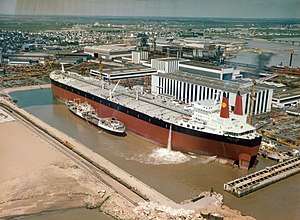Pierre Guillaumat (supertanker)
Pierre Guillaumat was a supertanker built in 1977 by Chantiers de l'Atlantique at Saint-Nazaire for Compagnie Nationale de Navigation. It was the third vessel of Batillus class supertankers (the other three, slightly smaller, were Batillus, Bellamya and Prairial) and distinguished for being the biggest ship ever constructed (by gross tonnage). It was surpassed in length, deadweight tonnage and displacement only by Seawise Giant[5][6], which, though it was originally smaller when it was built in 1976, was subsequently lengthened and enlarged.
 The oil tanker Batillus, Pierre Guillaumat sister ship at the end of her construction in Saint-Nazaire, being fueled by Port-Vendres. | |
| History | |
|---|---|
| Name: | Pierre Guillaumat |
| Owner: | Compagnie Nationale de Navigation, France |
| Operator: | Elf Aquitaine |
| Port of registry: |
|
| Builder: | |
| Yard number: | D26 |
| Launched: | August 16, 1977 |
| Completed: | October 1977 |
| In service: | October 1977 |
| Out of service: | 1983 |
| Identification: | IMO number: 7360150[1] |
| Fate: | Scrapped in Ulsan, South Korea October 1983 (Hyundai SB & Engineering Co) |
| General characteristics | |
| Class and type: | Batillus, ULCC |
| Tonnage: | |
| Length: | 414.23 m (1,359 ft 0 in)[1] |
| Beam: | 63.05 m (206 ft 10 in) |
| Draft: | 28.603 m (93 ft 10.1 in) |
| Installed power: | 47,840 kW[3] (65,000 Horsepower) |
| Propulsion: |
|
| Speed: | 16 knots (30 km/h) |
It was named after the French politician and founder of Elf Aquitaine oil industry Pierre Guillaumat and was completed in 1977. However, the poor state of the tanker market, accentuated by the huge dimensions of the ship that restricted where it could be employed, meant that the Pierre Guillaumat was unprofitable for most of its career and the vessel was laid up at Fujairah anchorage on February 2, 1983.[2] Later that year, it was bought by the Hyundai Corporation and renamed Ulsan Master, she arrived at Ulsan, South Korea for demolition on 19 October 1983.
Its gigantic proportions left Pierre Guillaumat with very limited employment opportunities. The vessel could not pass through either the Panama or Suez canals, and its draft meant it was only able to enter a small number of ports. It was therefore often moored at offshore rigs and oil terminals such as Antifer and, after lightering to reduce her draft, at Europoort.
Technical data
Length overall was 414.23 m, beam 63.05 m, draft 28.603 m, deadweight tonnage 555,051, and gross tonnage 274,838. Propulsion was provided by two propellers each driven by two Stal-Laval steam turbines developing a total power of 65,000 Hp. The service speed was 16.7 knots, with fuel consumption of about 330 tonnes[1] of heavy oil per day and fuel enough for 42 days.
The cargo was carried in 40 tanks with a total volume of 677,300 m3. They were divided into central and lateral tanks, whose dimensions were designed to reduce considerably the risk of pollution caused by collision or grounding. Ahead of the international standards of the time, the wing tanks had a maximum unit volume not exceeding 17,000 m3, which was reduced to 9,000 m3 in the most vulnerable parts of ship.
References
- "Pierre Guillaumat". Auke Visser's International Super Tankers.
- "Size restricts vessels' employment". Otago Daily News.
- "30 ans et plus de 500 millions de tonnes traitées par le terminal pétrolier d'Antifer". Marine Marchande.
- "Les pétroliers de 550.000 tonnes". Marine Marchande.
- "Jahre Viking - ( Biggest Ship Ever, After Reconstruction )". Auke Visser's International Super Tankers.
- ""Knock Nevis" ex. "Jahre Viking"". Auke Visser's International Super Tankers.